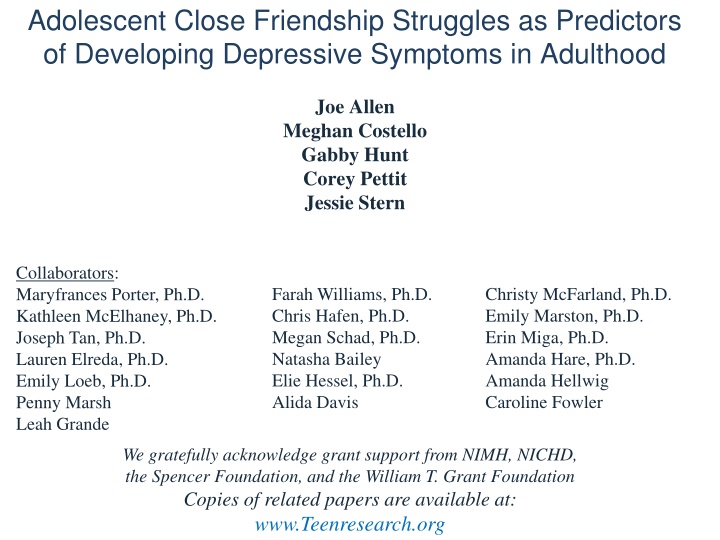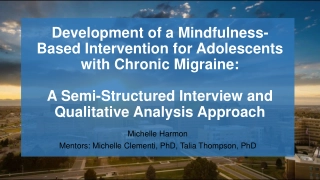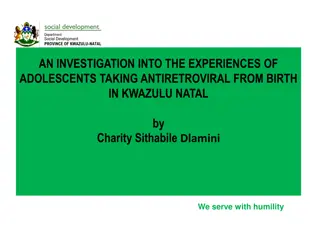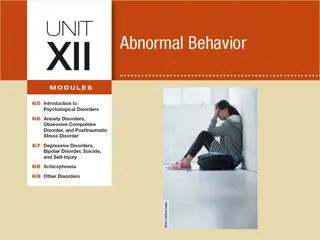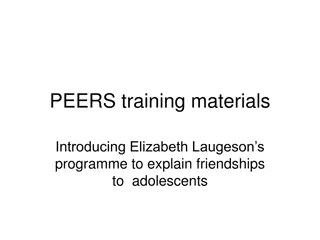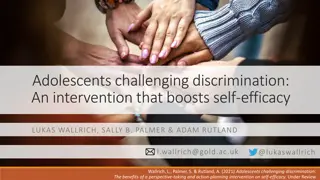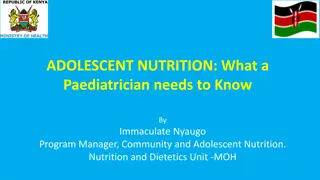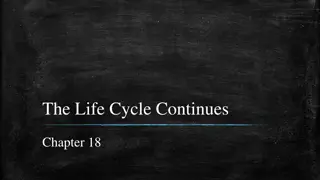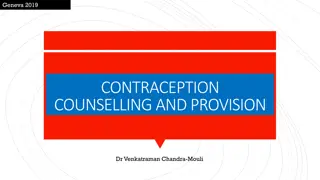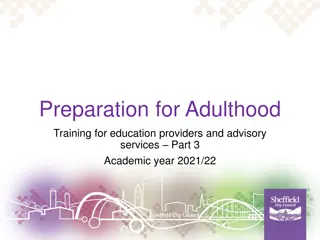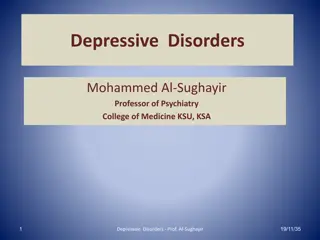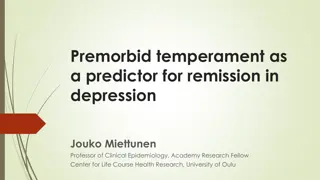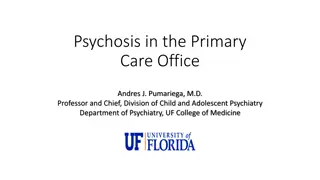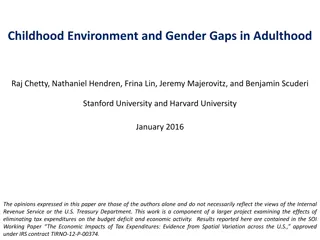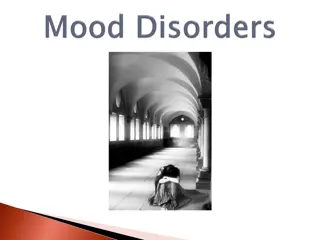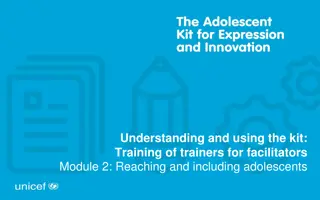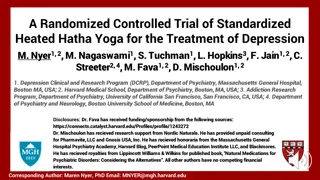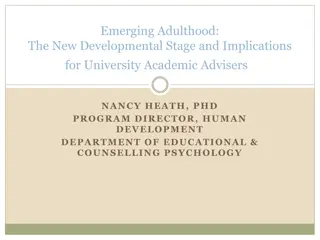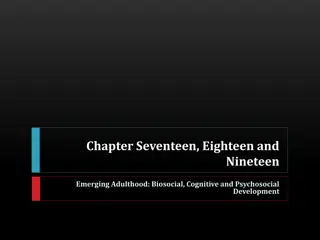Adolescents' Friendship Struggles Predict Depressive Symptoms in Adulthood
Study by Allen et al. explores how adolescent friendship challenges can lead to depressive symptoms in adulthood. Failure to meet social-developmental tasks in adolescence may impact mental health later on, affecting relationship quality, loneliness, and physical health. Understanding these predictors is crucial for prevention efforts in addressing the global rise in depression levels.
Download Presentation

Please find below an Image/Link to download the presentation.
The content on the website is provided AS IS for your information and personal use only. It may not be sold, licensed, or shared on other websites without obtaining consent from the author.If you encounter any issues during the download, it is possible that the publisher has removed the file from their server.
You are allowed to download the files provided on this website for personal or commercial use, subject to the condition that they are used lawfully. All files are the property of their respective owners.
The content on the website is provided AS IS for your information and personal use only. It may not be sold, licensed, or shared on other websites without obtaining consent from the author.
E N D
Presentation Transcript
Adolescent Close Friendship Struggles as Predictors of Developing Depressive Symptoms in Adulthood Joe Allen Meghan Costello Gabby Hunt Corey Pettit Jessie Stern Collaborators: Maryfrances Porter, Ph.D. Kathleen McElhaney, Ph.D. Joseph Tan, Ph.D. Lauren Elreda, Ph.D. Emily Loeb, Ph.D. Penny Marsh Leah Grande Farah Williams, Ph.D. Chris Hafen, Ph.D. Megan Schad, Ph.D. Natasha Bailey Elie Hessel, Ph.D. Alida Davis Christy McFarland, Ph.D. Emily Marston, Ph.D. Erin Miga, Ph.D. Amanda Hare, Ph.D. Amanda Hellwig Caroline Fowler We gratefully acknowledge grant support from NIMH, NICHD, the Spencer Foundation, and the William T. Grant Foundation Copies of related papers are available at: www.Teenresearch.org
Depression Today Single greatest source of disability worldwide (WHO, 2017) Dramatic recent increases in levels (even prior to pandemic) Need to understand its roots in order to guide prevention
A Developmental Tasks Perspective Adult depressive symptoms as a result of failure to meet critical social-developmental tasks Close friendship formation as a critical developmental task of adolescence Prior links to: Adult relationship quality Loneliness Multiple markers of physical health and aging Increasing depressive symptoms within adolescence
Why Being Socially Off-track Might Matter for Depressive Symptoms Might lead in adulthood to: Lack of day-to-day good quality interactions Poor romantic relationships General sense of failure to fit in with the human pack
Addressing Third Variable Explanations Perhaps prior psychological symptoms are driving friendship quality and future functioning Homotypic Continuity Prior levels of depressive symptoms Heterotypic Continuity Anxiety symptoms Externalizing symptoms
Following Young People From 13 to 30: To Pursue Three Goals 1. Examine meaningful symptom continuities 2. Explore long-term predictive role of adolescent friendship quality 3. Identify mediating processes from 13 to 30
Sample Other 5% Multiracial 8% 86 98 Black 29% White 58% Median Family Income: $40,000 Race Representation Followed from age 13 to 30 Data from Self-reports, close friends and mothers 94% participation in current phase
Depressive Symptoms (Ages 13-17, 24-26, 27-30) 27-item Childhood Depression Inventory (Kovacs & Beck, 1977) at 13-17 21-item Beck Depression Inventory (Beck& Steer, 1987) at all other ages Repeated annually with scores aggregated within each developmental period (13-17, 24-26, 27-30) Reduces effect of episodic nature of depressive experiences High internal consistency at all ages Cronbach s s = .86 - .90
Adolescent Close Friendship Struggles as Predictors of Developing Depressive Symptoms Adolescence (Ages 13-17) Adulthood (Ages 27-30) Depressive Symptoms Depressive Symptoms .33*** `
Anxiety Symptoms (Ages 13-17, 24-26) 21-item Beck Anxiety Inventory (Beck et al., 1988) Repeated annually with scores aggregated within each developmental period (13-17, 24-26) High internal consistency at all ages Cronbach s s = .90 - .94
Externalizing Symptoms (Close-friend s report, Ages: 15-17, 24-26) Externalizing Scale from Child Behavior Checklist (Achenbach, 1991; Achenbach & Edelbrock, 1981) at ages 15-17 21-items from an adapted short-form (Lizotte et al., 1992 Externalizing Scale from Adult Behavior Checklist (Achenbach et al., 2003) (34-items) Repeated annually with scores aggregated across years High internal consistency Cronbach s s = .85 - .93
Adolescent Close Friendship Struggles as Predictors of Developing Depressive Symptoms Adolescence (Ages 13-17) Adulthood (Ages 27-30) Depressive Symptoms Depressive Symptoms .25** .14* Anxiety Symptoms (Self-report) .14ns Externalizing Symptoms (Friend-report) `
Goal 1 (Heterotypic and Homotypic Continuities): Conclusions Depressive symptom levels display continuity from 13 to 30 Adolescent anxiety symptoms add to predictions of adult depressive symptoms over and above adolescent depressive symptoms
Adolescent Close Friendship Competence (Friend ratings Age 13-17, Maternal Rating Age 16) 4-item Adolescent Self-Perception Profile (Harter, 1988) Adapted for rating by others (i.e., Named Closest Friend, Maternal Rating) Friend rating occurs every year from 13-17 Results aggregated across years Maternal rating just once at age 16 Good internal consistency Cronbach s s = .65 to .74 (friend ratings) = .82 (maternal ratings)
Adolescent Close Friendship Struggles as Predictors of Developing Depressive Symptoms Adolescence (Ages 13-17) Adulthood (Ages 27-30) Close Friendship Quality (Maternal-report) -.21** Close Friendship Quality (Friend-report) -.18* Depressive Symptoms Depressive Symptoms .10ns .14ns Anxiety Symptoms (Self-report) .19** Externalizing Symptoms (Friend-report) `
Goal 2 (Long-term Predictive Role of Friendship Quality): Conclusions Long-term import of adolescent friendship quality for adult depressive symptoms Adolescent friendship quality is more strongly related to adult depressive symptoms than adolescent depressive symptoms Primacy of developmental tasks?
Close Friendship Quality in Early Adulthood (Friend ratings Age 24-26, Maternal Rating Age 23 Friend rating using 25-item Inventory of Parent and Peer Attachment (Armsden & Greenberg,1987) Maternal rating using 7-item Peer Relationship Quality measure from Young Adult Adjustment Scale (Capaldi et al., 1992) Good internal consistency Cronbach s s = .91 to .92 (friend ratings) = .76 (maternal ratings)
Two Routes to Adult Depressive Symptoms for MALES 1. Via Intervening Friendship Quality
Adolescent Close Friendship Struggles as Predictors of Developing Depressive Symptoms MALES Early Adulthood (Ages 24-26) Adolescence (Ages 13-17) Adulthood (Ages 27-30) Close Friendship Quality (Maternal-report) -.13* Close Friendship Quality (Friend-report) Close Friendship Quality (Maternal-report) .19* -.22** -.14* Externalizing Symptoms (Friend-report) Depressive Symptoms `
Two Routes to Adult Depressive Symptoms for MALES 1. Via Intervening Friendship Quality 2. Via Anxiety Symptoms
Adolescent Close Friendship Struggles as Predictors of Developing Depressive Symptoms MALES Early Adulthood (Ages 24-26) Adolescence (Ages 13-17) Adulthood (Ages 27-30) Close Friendship Quality (Maternal-report) Close Friendship Quality (Friend-report) Externalizing Symptoms (Friend-report) -.30*** Depressive Symptoms Depressive Symptoms .27** .51*** Anxiety Symptoms (Self-report) Anxiety Symptoms (Self-report) `
Two Routes to Adult Depressive Symptoms for MALES 1. Via Early Adult Friendship Quality 2. Via Early Adult Anxiety Symptoms There was a Lack of Continuity with Prior Depressive Symptoms Once 1. and 2. are taken into account
Adolescent Close Friendship Struggles as Predictors of Developing Depressive Symptoms MALES Early Adulthood (Ages 24-26) Adolescence (Ages 13-17) Adulthood (Ages 27-30) Close Friendship Quality (Maternal-report) -.13* Close Friendship Quality (Friend-report) Close Friendship Quality (Maternal-report) .19* -.22** -.14* Externalizing Symptoms (Friend-report) -.30*** Depressive Symptoms Depressive Symptoms Depressive Symptoms .22** .27** .51*** Anxiety Symptoms (Self-report) Anxiety Symptoms (Self-report) `
Two Routes to Adult Depressive Symptoms for FEMALES 1. Via Early Adult Friendship Quality
Adolescent Close Friendship Struggles as Predictors of Developing Depressive Symptoms FEMALES Adolescence (Ages 13-17) Early Adulthood (Ages 24-26) Adulthood (Ages 27-30) Close Friendship Quality (Maternal-report) -.13* Close Friendship Quality (Friend-report) Close Friendship Quality (Maternal-report) .16* -.21** -.14* Externalizing Symptoms (Friend-report) Depressive Symptoms `
Two Routes to Adult Depressive Symptoms for FEMALES 1. Via Early Adult Friendship Quality 2. Via Early Adult Depressive Symptoms
Adolescent Close Friendship Struggles as Predictors of Developing Depressive Symptoms FEMALES Adolescence (Ages 13-17) Early Adulthood (Ages 24-26) Adulthood (Ages 27-30) Close Friendship Quality (Maternal-report) Close Friendship Quality (Friend-report) Externalizing Symptoms (Friend-report) .35*** Depressive Symptoms Depressive Symptoms Depressive Symptoms .26** .69*** `
Two Routes to Adult Depressive Symptoms for FEMALES 1. Via Early Adult Friendship Quality 2. Via Early Adult Depressive Symptoms Depressive symptoms appear more salient/predictive for females in adolescence and early adulthood
Adolescent Close Friendship Struggles as Predictors of Developing Depressive Symptoms FEMALES Adolescence (Ages 13-17) Early Adulthood (Ages 24-26) Adulthood (Ages 27-30) Close Friendship Quality (Maternal-report) -.13* Close Friendship Quality (Friend-report) Close Friendship Quality (Maternal-report) .16* -.21** -.14* Externalizing Symptoms (Friend-report) .35*** Depressive Symptoms Depressive Symptoms Depressive Symptoms .26** .69*** -.27*** .35*** Anxiety Symptoms (Self-report) Anxiety Symptoms (Self-report) .17* `
Goal 3 (Mediated Pathways to Depressive Symptoms) Conclusions Different pathways for males vs. females For males: Path via anxiety up through early adulthood is most prominent For females: Path is more straightforwardly via depressive symptoms For both, early adult friendship quality continues to be a strong predictor.
Limitations Even lagged relations do not establish causality Addressing symptoms, not clinical depression, in a community sample Not considering other factors known to be linked to depressive symptoms (e.g., biological, cognitive, contextual) Copies of related papers are available at: www.Teenresearch.org
Overarching Conclusions Long-term role of friendship competence Even without causality, we ve established lack of friendship competence as a clear marker of risk A developmental task approach buys us more (empirically) than a focus on concurrent adolescent symptoms Need to approach preventive interventions with same social- developmental lens Paper is available as: Allen et al., Devel. & Psychopathology, 2022 Copies of related papers are available at: www.Teenresearch.org
The Connection Project: Reducing Teen Depressive Symptoms 12.9 12.7 12.5 * 12.3 12.1 11.9 11.7 11.5 Baseline Post-Intervention 4-month Follow-up The Connection Project Controls Allen et al., Devel. & Psychopathology, 2021,Costello et al., Amer Jnl of Community Psych, 2022)
We gratefully acknowledge grant support from NIMH, NICHD, the Spencer Foundation, and the William T. Grant Foundation and the many collaborators who ve made this study possible, some of whom are listed below: Farah Williams, Ph.D. Chris Hafen, Ph.D. Megan Schad, Ph.D. Lauren Everhart Elie Hessel, Ph.D. Meghan Costello Christy McFarland, Ph.D. Emily Marston, Ph.D. Erin Miga, Ph.D. Amanda Hare, Ph.D. Gabby Hunt Caroline Fowler Maryfrances Porter, Ph.D. Kathleen McElhaney, Ph.D. Joseph Tan, Ph.D. Lauren Elreda, Ph.D. Emily Loeb, Ph.D. Penny Marsh Leah Grande Copies of related papers are available at: www.Teenresearch.org
